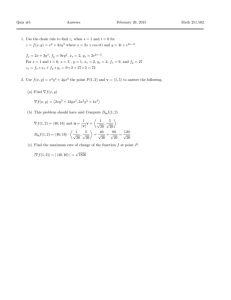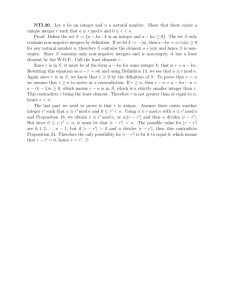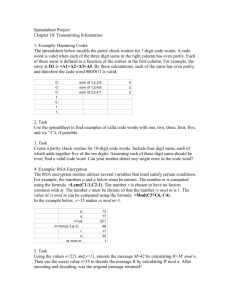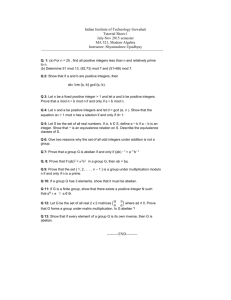A multidimensional version of a result of Davenport-Erd˝ os
advertisement
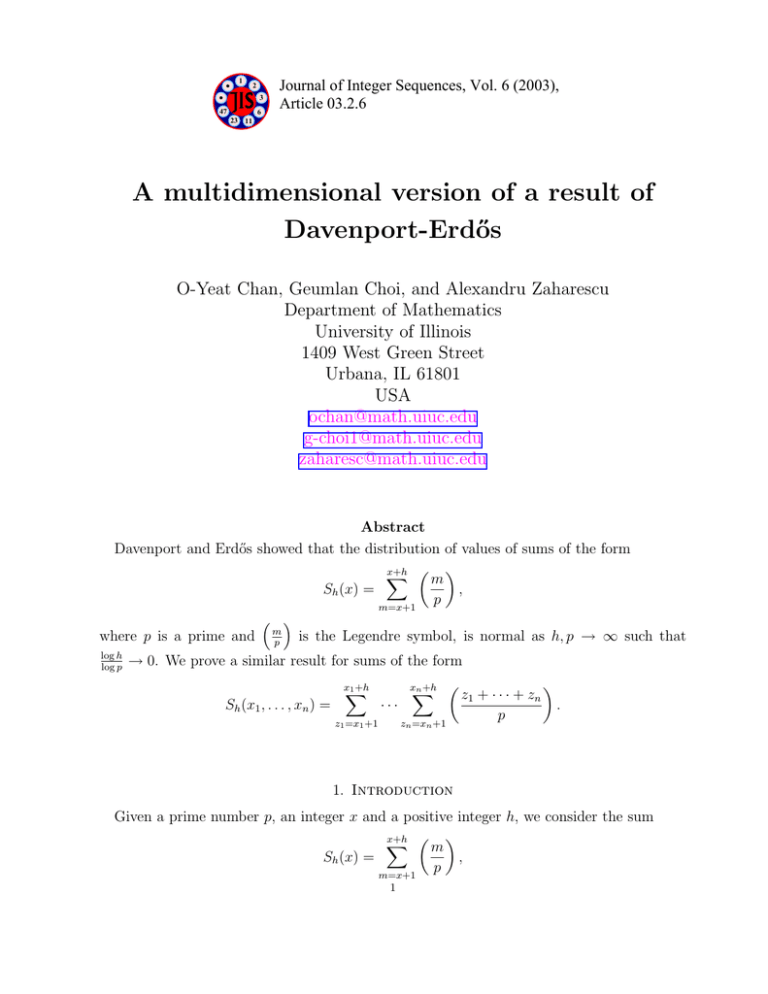
1
2
3
47
6
Journal of Integer Sequences, Vol. 6 (2003),
Article 03.2.6
23 11
A multidimensional version of a result of
Davenport-Erdős
O-Yeat Chan, Geumlan Choi, and Alexandru Zaharescu
Department of Mathematics
University of Illinois
1409 West Green Street
Urbana, IL 61801
USA
ochan@math.uiuc.edu
g-choi1@math.uiuc.edu
zaharesc@math.uiuc.edu
Abstract
Davenport and Erdős showed that the distribution of values of sums of the form
¶
x+h µ
X
m
Sh (x) =
,
p
m=x+1
³ ´
where p is a prime and mp is the Legendre symbol, is normal as h, p → ∞ such that
log h
log p
→ 0. We prove a similar result for sums of the form
Sh (x1 , . . . , xn ) =
xX
1 +h
z1 =x1 +1
···
xX
n +h
zn =xn +1
µ
z1 + · · · + z n
p
¶
.
1. Introduction
Given a prime number p, an integer x and a positive integer h, we consider the sum
¶
x+h µ
X
m
Sh (x) =
,
p
m=x+1
1
2
³ ´
where here and in what follows mp denotes the Legendre symbol. The expected value of
√
such a sum is h. If p is much larger than h, it is a very difficult problem to show that there
is any cancellation in an individual sum Sh (x) as above. The classical inequality of Pólya√
Vinogradov (see [8], [10]) shows that Sh (x) = O( p log p), and assuming the Generalized
√
Riemann Hypothesis, Montgomery and Vaughan [7] proved that Sh (x) = O( p log log p).
The results of Burgess [2] provide cancellation in Sh (x) for smaller values of h, as small
as p1/4 . One does expect to have cancellation in Sh (x) for h > p² , for fixed ² > 0 and p
large. This would imply the well-known hypothesis of Vinogradov that the smallest positive
quadratic nonresidue mod p is < p² , for any fixed ² > 0 and p large enough in terms of ².
We mention that Ankeny [1] showed that assuming the Generalized Riemann Hypothesis,
the smallest positive quadratic nonresidue mod p is O(log 2 p). It is much easier to obtain
cancellation, even square root cancellation, if one averages Sh (x) over x. In fact, Davenport
and Erdős [5] entirely solved the problem of the distribution of values of Sh (x), 0 ≤ x < p,
h
as h, p → ∞ such that log
→ 0. Under these growth conditions they showed that the
log p
distribution becomes normal. Precisely, they proved that
Z λ
1 2
1
1
√
Mp (λ) →
e− 2 t dt, as p → ∞,
p
2π −∞
1
where Mp (λ) is the number of integers x, 0 ≤ x < p, satisfying Sh (x) ≤ λh 2 .
For a fixed n ≥ 2, we consider multidimensional sums of the form
Sh (x1 , . . . , xn ) =
xX
1 +h
z1 =x1 +1
···
xX
n +h
zn =xn +1
µ
z1 + · · · + z n
p
¶
,
(1.1)
where p is a prime number, x1 , . . . , xn are integer numbers, and h is a positive integer. Upper
bounds for individual sums of this type have been provided by Chung [3]. In this paper we
investigate the distribution of values of these sums, and obtain a result similar to that of
Davenport and Erdős. Let
Z n
cn :=
f (t)2 dt,
(1.2)
0
where f (t) is the volume of the region in Rn−1 defined by
{(a1 , . . . , an−1 ) ∈ Rn−1 : 0 < ai ≤ 1, i = 1, . . . , n − 1; t − 1 ≤ a1 + · · · + an−1 < t}.
We will see that this constant cn naturally appears as a normalizing factor in our distribution
result below. Let Mn,p (λ) be the number of lattice points (x1 , . . . , xn ) with 0 ≤ x1 , . . . , xn <
p, such that
1
1
Sh (x1 , . . . , xn ) ≤ λcn2 hn− 2 .
Then we show that as h, p → ∞ such that
log h
log p
→ 0, one has
1
1
Mn,p (λ) → √
n
p
2π
Z
λ
t2
e− 2 dt.
−∞
3
2. Estimating the moments
We now proceed to estimate higher moments of our sums Sh (x1 , . . . , xn ).
Lemma 1. Let p be a prime number and let h and r be positive integers. Then
X
Sh2r (x1 , . . . , xn ) = 1 · 3 · · · (2r − 3)(2r − 1)
x1 ,...,xn (mod p)
´
³
¡
¢r ¡
¢
1
· cn h2n−1 + On,r (h2n−2 ) pn + Or (pn−1 ) + Or h2nr pn− 2 , (2.1)
and
X
x1 ,...,xn (mod p)
´
³
1
Sh2r−1 (x1 , . . . , xn ) = Or hn(2r−1) pn− 2 .
(2.2)
Proof. Consider first the case when the exponent is 2r. We have
¶
h µ
h
X
X
x1 + · · · + x n + a 1 + · · · + a n
···
Sh (x1 , . . . , xn ) =
.
p
a =1
a =1
n
1
Therefore
Sh2r (x1 , . . . , xn ) =
h
X
a1,1 =1
and so
X
···
h
X
an,1 =1
···
h
X
a1,2r =1
···
h
³
X
(x
1 +···+xn +a1,1 +···+an,1 )···(x1 +···+xn +a1,2r +···+an,2r )
p
an,2r =1
´
Sh2r (x1 , . . . , , xn )
x1 ,...,xn (mod p)
=
h
X
ai,j =1
1≤i≤n
1≤j≤2r
X
x1 ,...,xn (mod p)
³
(x1 +···+xn +a1,1 +···+an,1 )···(x1 +···+xn +a1,2r +···+an,2r )
p
´
.
Divide the sets of n-tuples {(a1,i , . . . , an,i ) : i = 1, . . . , 2r} into two types. If there exists
an i such that the number of j ∈ {1, . . . , 2r} for which a1,i + · · · + an,i = a1,j + · · · + an,j
is odd, we say that it is of type 1. The others will be of type 2. First consider the sum of
terms of type 1. Since for each fixed x2 , . . . , xn , the product (x1 + · · · + xn + a1,1 + · · · +
an,1 ) · · · (x1 + · · · + xn + a1,2r + · · · + an,2r ), as a polynomial in x1 , is not congruent mod p to
the square of another polynomial, by Weil’s bounds [11] we have
´
X
X ³
(x1 +···+xn +a1,1 +···+an,1 )···(x1 +···+xn +a1,2r +···+an,2r )
p
x2 ,...,xn (mod p)
x1 (mod p)
=
X
1
Or (p1/2 ) = Or (pn− 2 ).
x2 ,··· ,xn (mod p)
³
´
1
So the sum of terms of type 1 is Or h2nr pn− 2 . Now consider the sum of terms of type 2.
Since the polynomial (x1 + · · · + xn + a1,1 + · · · + an,1 ) · · · (x1 + · · · + xn + a1,2r + · · · + an,2r ) is
a perfect square in this case, the Legendre symbol is 1, except for those values of x1 , . . . , xn
4
for which this product vanishes mod p. Since the product has at most r distinct factors,
for any values of x2 , . . . , xn there are at most r values of x1 for which the product vanishes
mod p. Thus the sum over x1 , . . . , xn is at most pn , and at least (p − r)pn−1 . Hence the
contribution of terms of type 2 is
¡
¢
F (h, n, r) pn + Or (pn−1 ) ,
where F (h, n, r) is the number of sets {(a1,i , . . . , an,i ) : i = 1, . . . , 2r} yielding multinomials of
type 2, i.e., sets for which each value of a1,i +· · ·+an,i occurs an even number of times, as i runs
over the set {1, 2, . . . , 2r}. For any integer m with n ≤ m ≤ nh, let Nm (h, n) be the number
of n-tuples (a1,i , . . . , an,i ) for which 1 ≤ a1,i , . . . , an,i ≤ h and a1,i + · · · + an,i = m. Then the
number of pairs of n-tuples (a1,i , . . . , an,i ), (a1,j , . . . , an,j ), with a1,i +· · ·+an,i = a1,j +· · ·+an,j ,
P
number
is m (Nm (h, n))2 . In what follows we write simply Nm instead of Nm (h,
Pn). 2The
r
of ways to choose r such pairs of n-tuples (not necessarily distinct) is ( m Nm ) , and the
number of ways to arrange these pairs in 2r places is (2r − 1)(2r − 3) · · · 3 · 1. Hence,
Ã
!r
X
2
F (h, n, r) ≤ 1 · 3 · · · (2r − 3)(2r − 1)
.
Nm
m
On the other hand, the number of ways of choosing r pairs of distinct sums is at least
!
!
Ã
!Ã
Ã
X
X
X
2
2
2
2
2
Nm − (r − 1) max{Nm }
Nm − max{Nm } · · ·
Nm
m
m
m
≥
Ã
X
m
m
2
2
Nm
− r max{Nm
}
m
!r
m
,
and the number of different ways to arrange them in 2r places is (2r − 1)(2r − 3) · · · 3 · 1.
Thus
!r
Ã
X
2
2
Nm
− r max Nm
1 · 3 · · · (2r − 3)(2r − 1)
≤ F (h, n, r)
m
m
≤ 1 · 3 · · · (2r − 3)(2r − 1)
Ã
X
2
Nm
m
!r
.
Next, we estimate the number Nm (h, n) = Nm . It is clear that for any m with 0 < m ≤ nh,
Nm is the number of lattice points in the region Rm in Rn−1 given by
(
0 < ai ≤ h, for i = 1, . . . , n − 1;
Rm :=
m − h ≤ a1 + · · · + an−1 < m.
We send the region Rm to the unit cube in Rn−1 via the map x 7→ xh . Then we have
(
0 < ai ≤ 1, for i = 1, . . . , n − 1;
Rm := m
− 1 ≤ a1 + · · · + an−1 < m
.
h
h
By the Lipschitz principle [4] we know that
Nm = vol(Rm ) + On (hn−2 ) = hn−1 vol(Rm ) + On (hn−2 ).
5
With f defined as in the Introduction, we may write vol(R m ) = f ( m
). Then
h
³ ³ m ´´2
X
X
X
2
Nm
=
h2n−2 f
+
On (h2n−3 )
h
0<m≤nh
0<m≤nh
0<m≤nh
X ³ ³ m ´´2 1
+ On (h2n−2 )
= h2n−1
f
h
h
0<m≤nh
Z n
2n−1
(f (t))2 dt + On (h2n−2 )
=h
0
=h
2n−1
cn + On (h2n−2 ),
as h → ∞.
Hence
¡
¢r
F (h, n, r) = 1 · 3 · · · (2r − 3)(2r − 1) cn h2n−1 + On,r (h2n−2 ) ,
and (2.1) follows. It is clear that (2.2) holds, since there are no sets of type 2 in this case.
This completes the proof of the lemma.
¤
3. Main results
By using the estimates for the higher moments of Sh (x1 , . . . , xn ) given in Lemma 1, we show
that under appropriate growth conditions on h, p, the distribution of our sums S h (x1 , . . . , xn )
is normal.
Theorem 1. Let h be any function of p such that
log h
h → ∞,
→ 0 as p → ∞.
(3.1)
log p
Let Mn,p (λ) denote the number of lattice points (x1 , . . . , xn ), 0 ≤ x1 , . . . , xn < p, such that
1
1
Sh (x1 , . . . , xn ) ≤ λcn2 hn− 2 ,
with Sh (x1 , . . . , xn ) defined by (1.1) and cn defined by (1.2). Then
Z λ
2
1
1
− t2
√
e
M
(λ)
→
dt, as p → ∞.
n,p
pn
2π −∞
Proof. We consider the sum
1
pn
X
x1 ,...,xn (mod p)
µ
1
1/2
cn hn−1/2
Sh (x1 , . . . , xn )
¶r
.
(3.2)
It follows from the above lemma that for each fixed r and n, if r is even, then the quantity
from (3.2) is
µ ¶¶r µ
µ ¶¶
µ
r
1
1
1
1 · 3 · · · (r − 3)(r − 1) 1 + On,r
1 + Or
+ On,r (h 2 p− 2 ),
h
p
r
1
while if r is odd, the quantity from (3.2) is On,r (h 2 p− 2 ). Using (3.1), we have that for each
positive integer r,
µ
¶r
X
1
1
Sh (x1 , . . . , xn ) → µr , as p → ∞,
(3.3)
1/2
pn
cn hn−1/2
x1 ,...,xn (mod p)
6
(
1 · 3 · · · (r − 1), if r is even;
0,
if r is odd.
Let Nn,p (s) be the number of n-tuples (x1 , . . . , xn ) with 0 ≤ xi < p, i = 1, . . . , n such that
Sh (x1 , . . . , xn ) ≤ s. Then Nn,p (s) is a non-decreasing function of s with discontinuities at
certain integral values of s. We also note that Nn,p (s) = 0 if s < −hn , Nn,p (s) = pn if s ≥ hn ,
where µr =
1
1
and Mn,p (λ) = Nn,p (λcn2 hn− 2 ). We write (3.3) in the form
!r
Ã
hn
1 X
s
(Nn,p (s) − Nn,p (s − 1)) → µr ,
pn s=−hn c 21 hn− 12
n
as p → ∞.
(3.4)
This is similar to relation (26) of Davenport-Erdős [5]. Following their argument, if we set
Φn,p (t) =
1
1
1
1
2 n− 2
) = n Mn,p (t),
N
(tc
h
n
n,p
n
p
p
and
1
Φ(t) = √
2π
we obtain
Z
∞
r
−∞
t dΦn,p (t) →
Z
Z
t
1
2
e− 2 u du,
−∞
∞
tr dΦ(t),
−∞
as p → ∞,
(3.5)
for any fixed positive integer r, which is the analogue of relation (28) from [5]. It now remains
to show that, for each real number λ,
Φn,p (λ) → Φ(λ),
as p → ∞.
(3.6)
The assertion of (3.6) follows from the well-known fact (see [6]) in the theory of probability
that if Fk and F are probability distributions with finite moments mk,r , mr of all orders,
respectively, and if F is the unique distribution with the moments mr such that mk,r → mr
for all r as k → ∞, then Fk → F as k → ∞. We give the outline of the proof following the
argument of Davenport-Erdős [5]. Suppose that (3.6) fails for some λ. Then we can find a
subsequence {Φn,p0 } and a δ > 0 such that
|Φn,p0 (λ) − Φ(λ)| ≥ δ,
for all p0 .
(3.7)
By the two theorems of Helly (see the introduction to [9]) there exists a subsequence {Φ n,p00 }
of {Φn,p0 } which converges to a distribution Ψ at every point of continuity, and
Z ∞
Z ∞
Z ∞
r
r
t dΨ(t) = 00lim
t dΦn,p00 =
tr dΦ(t).
−∞
p →∞
−∞
−∞
Since Φ is the only distribution with these special moments µ1 , µ2 , . . ., we have Ψ(t) = Φ(t)
for all t. This contradicts (3.7). Hence one concludes that, as p → ∞,
Z λ
1 2
1
1
e− 2 t dt,
Mn,p (λ) = Φn,p (λ) → Φ(λ) = √
n
p
2π −∞
which completes the proof of the theorem.
¤
7
We remark that cn can be explicitly computed for any given value of n. The following
proposition provides an equivalent formulation of cn , which allows for easier computations
in higher dimensions. For any n, consider the polynomial in two variables
à l
¶!2
µ ¶µ
n−1
X
X
n X + (l − k)Y + n − 1
.
(−1)k
gn (X, Y ) =
n−1
k
k=0
l=0
Note that the total degree of gn (X, Y ) is at most 2n − 2.
Proposition 1. For any n,
cn =
2n−2
X
k=0
k
where an,k is the coefficient of X Y
2n−2−k
an,k
,
k+1
in gn (X, Y ).
Proof. We know that for fixed n and h → ∞,
X
2
Nm
= h2n−1 cn + On (h2n−2 ),
m
where Nm = Nm (h, n) is the number of n-tuples (a1 , . . . , an ) such that a1 + · · · +
Pan =2 m,
0
with 1 ≤ ai ≤ h. Replacing m by m = m − n and each ai by bi = ai − 1, we get m Nm =
P
0 2
0
0
m0 (Nm0 ) , where Nm0 is the number of n-tuples (b1 , . . . , bn ) such that b1 + · · · + bn = m ,
with 0 ≤ bi ≤ h − 1.
Now, the number
of¢ ways to obtain a sum of m0 from n non-negative integers, with no
¡m0 +n−1
. If we restrict any fixed bi to satisfy the inequality bi ≥ h, then the
restrictions, is
n−1
¡ 0
¢
number of ways drops to m −h+n−1
. If we restrict any two bi , bj to satisfy bi , bj ≥ h then
n−1
¡m0 −2h+n−1¢
we have
ways, and so on.
n−1
¡ ¢
Since for each k, there are nk ways to choose exactly k of the bi ’s to be greater than h,
we obtain by the inclusion-exclusion principle,
¶
µ ¶µ 0
X
m − kh + n − 1
0
k n
Nm0 =
.
(−1)
n−1
k
0
0≤k≤m /h
So we have, for lh ≤ m0 < (l + 1)h, 0 ≤ l ≤ n − 1,
¶
µ ¶µ 0
l
X
m − kh + n − 1
0
k n
Nm0 =
(−1)
.
n−1
k
k=0
Replacing m0 by s + lh, with 0 ≤ s ≤ h − 1, we get
µ ¶µ
¶
l
X
s + (l − k)h + n − 1
k n
0
(−1)
Ns+lh =
.
k
n−1
k=0
Therefore
X
m0
0 2
(Nm
0)
=
n−1 µ X
l
h−1 X
X
s=0 l=0
¶¶2
µ ¶µ
n s + (l − k)h + n − 1
(−1)
n−1
k
k=0
=
k
h−1
X
s=0
gn (s, h).
8
It follows that
h−1
X
gn (s, h) = h2n−1 cn + On (h2n−2 ).
(3.8)
s=0
Now, the main contribution in gn (s, h) comes from the terms where the exponents of s and
h add up to 2n − 2. Since for any 0 ≤ k ≤ 2n − 2,
h−1
X
sk =
s=0
we obtain
h−1
X
gn (s, h) =
s=0
h−1
X
s=0
=
Ã2n−2
X
1
hk+1 + On (hk ),
k+1
an,k sk h2n−2−k + lower order terms
k=0
h−1
2n−2
XX
!
an,k sk h2n−2−k + On (h2n−2 )
k=0 s=0
=
2n−2
X
k=0
an,k 2n−1
h
+ On (h2n−2 ).
k+1
By combining this with (3.8), we obtain the desired result.
¤
151
15619
655177
, c4 = 315
, c5 = 36288
, c6 = 1663200
. The
For n = 2, 3, 4, 5, 6, one finds that c2 = 23 , c3 = 11
20
numerator and the denominator of cn grow rapidly as n increases. For instance, for n = 10
and n = 25 we have
37307713155613
c10 =
,
121645100408832
and
675361967823236555923456864701225753248337661154331976453
.
c25 =
3465993527260783822633915460520201577706853740052480000000
One can also work with boxes instead of cubes, and obtain similar distribution results. For
example, in dimension two, we may consider the sum
¶
y+k µ
x+h X
X
u+v
,
Sh,k (x, y) =
p
u=x+1 v=y+1
where x, y are any integers and h, k are positive integers, with h ≥ k, say. Then, by using
the same arguments as in the proof of Theorem 1, one can prove the following result.
Theorem 2. Let h, k be functions of p such that
h
log k
h ≥ k,
→ α, k → ∞,
→ 0, as p → ∞.
k
log p
q
q
1
Denote β =
α − 13 and β 0 =
1 − 3α
. Let Mp (λ) be the number of pairs (x, y) with
3
0 ≤ x, y < p, x, y integers, such that Sh,k (x, y) ≤ λβk 2 . Let Mp 0 (λ) be the number of pairs
1
(x, y) with 0 ≤ x, y < p, x, y integers, such that Sh,k (x, y) ≤ λβ 0 h 2 k. Then, as p → ∞,
Z λ
1 2
1
1
e− 2 x dx,
Mp (λ) → √
2
p
2π −∞
9
and
1
1
0
√
M
(λ)
→
p
p2
2π
Z
λ
1 2
e− 2 x dx.
−∞
We remark that when h is much larger than k, Sh,k (x, y) is close to k times the 1dimensional sum Sh (x + y). Also, in this case α is large, β 0 is close to 1, and the above
statement for Mp 0(λ) approaches the 1-dimensional
result of Davenport and Erdős. Note
p
√
also that in case α = 1, we have β = 2/3 = c2 , and the statement of Theorem 2 for
Mp (λ) coincides with that of Theorem 1 for n = 2.
References
[1]
[2]
[3]
[4]
[5]
[6]
[7]
[8]
[9]
[10]
[11]
N. C. Ankeny, The least quadratic nonresidue, Ann. of Math. (2) 55 (1952), 65–72.
D. A. Burgess, On character sums and L-series. II, Proc. London Math. Soc. (3) 13 (1963), 524–536.
F. R. K. Chung, Several generalizations of Weil sums, J. Number Theory 49 (1994), 95–106.
H. Davenport, On a principle of Lipschitz, J. London Math. Soc. 26 (1951), 179–183.
H. Davenport and P. Erdős, The distribution of quadratic and higher residues, Publ. Math. Debrecen 2
(1952), 252–265.
W. Feller, An Introduction to Probalility Theory and Its Applications, Vol. 2, 2nd edition, Wiley, New
York, 1971.
H. L. Montgomery and R. C. Vaughan, Exponential sums with multiplicative coefficients, Invent. Math.
43 (1977), 69–82.
G. Pólya, Uber die verteilung der quadratischen Reste und Nichtreste, Nachrichten K. Ges. Wiss.
Göttingen (1918), 21–29.
J. A. Shohat and J. D. Tamarkin, The Problem of Moments, Math. Surveys No. 1, Amer. Math. Soc.,
New York, 1943.
I. M. Vinogradov, Sur la distribution des résidus et des non-résidus des puissances, J. Phys.-Math. Soc.
Perm. 1 (1919), 94–98.
A. Weil, On some exponential sums, Proc. Natl. Acad. Sci. USA 34 (1948), 204–207.
2000 Mathematics Subject Classification: Primary 11T99; Secondary 11A15.
Keywords: Legendre symbol, normal distribution.
Received February 24, 2003; revised version received June 16, 2003. Published in Journal of
Integer Sequences, July 9, 2003.
Return to Journal of Integer Sequences home page.
